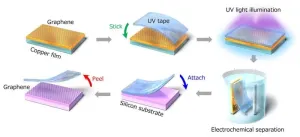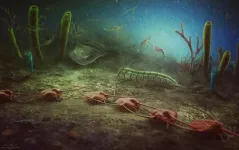(Press-News.org) Hot water tanks, washing machines, kettles: limescale forms in every domestic appliance that comes into contact with (hot) water – especially in areas where the water is hard, meaning high in calcium. Often the only thing that helps is to use vinegar or a special descaler to dissolve the rock-hard deposits and restore the appliance’s functionality.
This is a nuisance in households – and an expensive problem in thermal power stations, for example those that generate electricity, where the formation of limescale is known as fouling. Heat exchangers are particularly prone to limescale, which greatly reduces the efficiency of the systems: a layer of limescale just one millimetre thick in the heat exchanger’s pipes reduces the efficiency of electricity production by approximately 1.5 percent. To compensate for these losses an additional 8.7 million tonnes of hard coal would have to be burned. That’s bad for the carbon footprint and the climate, and it’s expensive for the electricity producers.
Innovative limescale-repellent surface
A research team from ETH Zurich and the University of California, Berkeley has now found a possible solution to this problem: a special limescale-repellent coating with microscopically small ridges that prevent the adhesion of limescale crystals. The team’s study was recently published in the journal Science Advances.
Fundamental research into the development of limescale-repellent surfaces has been sparse. So the researchers, led by former ETH Professor Thomas Schutzius, took a close look at the interactions among individual growing limescale crystals, the surrounding water flow and the surface at the microscopic level.
Based on this, Schutzius’ doctoral student Julian Schmid and other team members developed several coatings from various soft materials and tested them in the lab at ETH Zurich.
Hydrogel with microstructure is most effective
The most effective coating turned out to be a polymer hydrogel, the surface of which is covered in tiny ridges thanks to microtextured moulds, which the researchers fabricated using photolithography.
The hydrogel’s microstructure is reminiscent of natural models such as shark scales, which also have a ribbed structure to suppress fouling on the sharks’ skin.
In kettles or boilers, the riblets ensure that the limescale crystals have less contact with the surface, meaning they can’t adhere and are thus easier to remove; water flowing over the hydrogel and through the ribbed structure carries them away. While the coating can’t fully prevent limescale crystals from forming, the constant passive removal of the microscopic crystals stops them growing together to form a tenacious layer.
In producing the different coatings, the researchers primarily varied the polymer content. The lower the polymer content and the higher the water content, the less well the calcium carbonate crystals adhere to the surface.
Tests with model particles made of polystyrene show that the coating’s surface structures must be smaller than the particles that are deposited on it. This reduces the contact surface and thus the adhesive force. “We varied the material’s surface structure to achieve the greatest efficiency, then carried out the crystal experiments with this optimum structure size,” Schmid says.
The team’s experiments show that the hydrogel coating is very effective: when water flowed across the hydrogel-coated surface, on which limescale crystals with a size of around 10 micrometres had previously been grown, up to 98 percent of the crystals were removed.
Eco-friendly solution
The researchers emphasise that their solution is more eco-friendly and more efficient than existing approaches to descaling, some of which involve toxic and aggressive chemicals. In contrast, the hydrogel is biocompatible and environmentally friendly. The technology behind this solution should also be scalable: the coating could be applied in various ways that are already in use in industry today.
Rather than applying for a patent for their development, the researchers have deliberately decided in favour of publication in a scientific journal. This means that all interested parties are free to further develop and utilise the new coating.
Schutzius received an ERC Starting Grant for this research in 2019. He no longer works at ETH Zurich, and is now an assistant professor of mechanical engineering at UC Berkeley.
END
Innovative coating prevents limescale formation
2024-02-09
ELSE PRESS RELEASES FROM THIS DATE:
Novel technique has potential to transform breast cancer detection
2024-02-09
OAK BROOK, Ill. – An innovative breast imaging technique provides high sensitivity for detecting cancer while significantly reducing the likelihood of false positive results, according to a study published today in Radiology: Imaging Cancer, a journal of the Radiological Society of North America (RSNA). Researchers said the technique has the potential to offer more reliable breast cancer screening for a broader range of patients.
Mammography is an effective screening tool for early detection of breast cancer, but its sensitivity ...
Children's Hospital Colorado accepted as one of nine core sites nationally in the prestigious Pediatric Heart Network
2024-02-09
Children’s Hospital Colorado (Children’s Colorado) is announcing its recent acceptance into the Pediatric Heart Network (PHN), a collective of leading hospitals working to improve outcomes and quality of life for children – and more recently adults – with heart disease. The hospital’s Heart Institute will become one of nine clinical research centers across North America selected to be a part of this national network.
“We are thrilled to be accepted as a new core site for the Pediatric Heart Network,” said Shelley Miyamoto, MD, professor and Jack Cooper Millisor Chair of Pediatric Cardiology ...
New tumor spatial mapping tool will help clinicians assess aggressiveness of cancer and personalize treatment
2024-02-09
Scientists have developed a new AI tool that maps the function of proteins in a cancerous tumour, enabling clinicians to decide how to target treatment in a more precise way.
In cancers such as clear cell renal cell carcinoma (ccRCC), responses to existing treatments are different for each patient, making it difficult to identify the right drug treatment regime for each patient.
For example, cancer therapeutic Belzutifan has recently been approved to treat ccRCC, but only has a response rate of 49% in patients with the most common form of the condition.
To understand better why some patients respond better than others, researchers from the Universities of Bath and Nottingham studied ...
Certain older Americans show hesitation around brain scan research
2024-02-09
Asian Americans are less likely than their white peers to participate in health research involving MRIs and addressing this hesitancy could improve research, according to a Rutgers Health-led study.
Findings by the researchers, published in Alzheimer's & Dementia: Translational Research & Clinical Interventions, a journal of the Alzheimer’s Association, surveyed older adults about their experiences and perceptions of MRI brain imaging scans, their desire to learn results of scans and their attitudes related to dementia and overall research participation.
According to the study, South Asian older adults – those 65 and older – are less likely than older white adults ...
Migration solves exoplanet puzzle
2024-02-09
Ordinarily, planets in evolved planetary systems, such as the Solar System, follow stable orbits around their central star. However, many indications suggest that some planets might depart from their birthplaces during their early evolution by migrating inward or outward. This planetary migration might also explain an observation that has puzzled researchers for several years: the relatively low number of exoplanets with sizes about twice as large as Earth, known as the radius valley or gap. Conversely, there are many exoplanets smaller and larger than this size.
“Six years ago, a reanalysis of data from the Kepler space telescope revealed a shortage of exoplanets with sizes around ...
New adhesive tape picks up and sticks down 2D materials as easily as child’s play
2024-02-09
Fukuoka, Japan – Materials just atoms in thickness, known as two-dimensional (2D) materials, are set to revolutionize future technology, including in the electronics industry. However, commercialization of devices that contain 2D materials has faced challenges due to the difficulty in transferring these extremely thin materials from where they are made onto the device.
Now, a research team from Kyushu University, in collaboration with Japanese company Nitto Denko, have developed a tape that can be used to stick 2D materials to many different surfaces, in an ...
Researchers discover cosmic dust storms from Type Ia supernova
2024-02-09
Cosmic dust—like dust on Earth—comprises groupings of molecules that have condensed and stuck together in a grain. But the exact nature of dust creation in the universe has long been a mystery. Now, however, an international team of astronomers from China, the United States, Chile, the United Kingdom, Spain, etc., has made a significant discovery by identifying a previously unknown source of dust in the universe: a Type Ia supernova interacting with gas from its surroundings.
The study was published in Nature Astronomy on Feb. 9, and was led by Prof. WANG Lingzhi from the South America Center for Astronomy of the Chinese Academy ...
New fossil site of worldwide importance uncovered in southern France
2024-02-09
Nearly 400 exceptionally well-preserved fossils dating back 470 million years have been discovered in the south of France by two amateur paleontologists. This new fossil site of worldwide importance has been analyzed by scientists from the University of Lausanne, in collaboration with the CNRS and international teams. This discovery provides unprecedented information on the polar ecosystems of the Ordovician period.
Paleontology enthusiasts have unearthed one of the world's richest and most diverse fossil sites from the Lower Ordovician period (around 470 million ...
Global study: Wild megafauna shape ecosystem properties
2024-02-09
For millions of years, a variety of large herbivores, or megafauna, influenced terrestrial ecosystems. Among many others, these included elephants in Europe, giant wombats in Australia, and ground sloths in South America. However, these animals experienced a wave of extinctions coinciding with the worldwide expansion of humans, leading to dramatic but still not fully understood changes in ecosystems. Even the survivors of these extinctions strongly declined, and many are currently threatened with extinction.
While there are many case studies as well as theories about the effects of large animals, formal attempts to quantitatively synthesize their effects and establish ...
Towards A Better Way of Releasing Hydrogen Stored in Hydrogen Boride Sheets
2024-02-09
The looming threat of climate change has motivated scientists worldwide to look for cleaner alternatives to fossil fuels, and many believe hydrogen is our best bet. As an environmentally friendly energy resource, hydrogen (H2) can be used in vehicles and electric power plants without releasing carbon dioxide into the atmosphere.
However, storing and transporting H2 safely and efficiently remains a challenge. Compressed gaseous hydrogen poses a significant risk of explosion and leakage, whereas liquid hydrogen must be maintained at extremely low temperatures, ...








